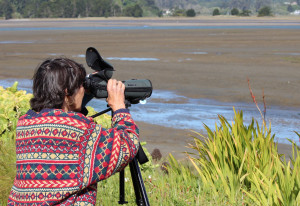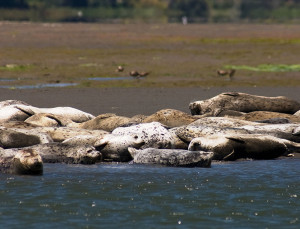It’s low tide at Duxbury Point in Bolinas and from the top of a weathered lookout point the shale reef below is potholed by tide pools.
Through a pair of binoculars, several blimp-like shapes are shimmering in the distance. To the untrained eye they appear to be nothing more than the morning sun reflecting off the algae. But for Bonnie Felix, a harbor seal monitor, they are a point of excitement.
“You can almost see them with the naked eye,” says Felix. “Those guys might be the only ones out there.”
March through June marks the annual pupping season for the San Francisco Bay Area’s most abundant and only year round resident pinniped: the harbor seal (although a common sight in the Bay Area, the California sea lion breeds from the Channel Islands to Baja). The best time to watch harbor seals is the first week of May.

Harbor seal populations span from the Bering Sea to Baja, California. But Point Reyes National Seashore, with its pristine coastline and protected waters, plays host to the largest concentration in California.
As such, for the past 30 years researchers have convened on the area to monitor the population during the pupping and molting season. As part of the National Park Service’s Pinniped Monitoring Program, the data collected is used to estimate population size and reproductive trends, and identify any new or existing threats to the colony. As an ‘apex’ predator, harbor seals are often the first to respond to ecosystem changes, so the data collected also gives a broader indication of marine health.
Duxbury Point
Atop the cliffside at Duxbury Point, the sun’s warm rays are no match for the blustery ocean winds and Felix, swaddled in a thick sweater, stops to take a sip of her tea. After setting up her spotting scope, she peers through and begins counting in a hushed voice.
Felix, a retired psychologist and Point Reyes local, is one of 30 volunteers participating in the program this year, 10 of whom are new recruits.
“I’ve been a volunteer for the past four or five seasons, but I heard about [the program] from others who have been involved for about 15 years,” she says, noting the 14 seals she counted on Duxbury reef. “I thought, does that just sound perfect or what? This is definitely for me.”
Harbor seals, famous for those endless black eyes and canine features, are classified as a ‘true seal,’meaning unlike their sea lion relatives they do not walk on all four flippers but instead, undulate to move around on shore. Because of their small size and thin blubber layer, harbor seals cannot maintain their body temperature for long periods of time in cold water. This is why they are most often spotted hauled out on sandbars and reefs, lazing in the sun to warm up and rest.

“Duxbury is more exposed, so it’s not a typical haul-out spot,” explains Felix. ”It’s more like a little rest spot as they swim to other sites (with their pups).”
“It’s often good to stay and watch for a while because it was only when that one raised its head that I could tell it was definitely bigger than a newborn. It would have been amazing if there was a pup out here.”
At the beginning of the pupping season, volunteers participate in field training days where they are taught how to monitor sites for demographic and geographical information as well as human or environmental disturbances. It was during a field training session a few years ago led by Dr. Sarah Allen, the National Park Service Ocean and Coastal Resources Program Coordinator, that Felix was fortunate enough to witness a female harbor seal give birth at one of the main pupping sites, Drakes Estero.
“We were looking through the scopes and Sarah Allen said to everyone, ‘see that very pregnant female to the left over there? She’s going to give birth very soon,’” says Felix. “’We know that because the seagull sitting next to her is waiting to let the other seagulls know so they can get the placenta.’”
Felix explains that moments later the mother became agitated and began moving around in a circle. After spreading her back flippers out, the birth was “done in a second, just like that.”
Harbor seals, like all pinnipeds, give birth on land on either tidal sand bars, reefs or pocket beaches. Despite this, pups are born knowing how to swim and will often enter the water minutes after birth.
“It was phenomenal – within ten minutes they were doing the most amazing water ballet to bond,” says Felix. “That really sold me on it!”
Pickleweed Island
This morning she is not only surveying Duxbury Point, but also three sub-sites at Bolinas Lagoon. Parked on the side of Highway 1, she sets up her spotting scope and focuses on Pickleweed Island where two large groups are hauled out on the sandbar, oblivious to the constant stream of traffic beside them.
With large groups hauled out in tight knit circles it can be quite a challenge to find where one seal ends and another begins. It takes some time to develop an eye for counting.
“It can be frustrating – especially in the beginning – as it’s so much harder to count when you’re new,” she says.“With a big group you might be counting and you think, did I count that guy? Oh god! I have to count all over again- it’s funny!”

During the pupping season mother seals will spend more time onshore nursing their pups and resting for an average of 10-12 hours per day. Pups wean at approximately 4 to 6 weeks, during which time they have nearly doubled in weight thanks to their mothers’ nutritious milk.
During this period pups are easily identified as they are significantly smaller than juveniles and rarely leave their mothers’ sides. The majority of pups basking on Pickleweed Island have not yet developed that mottled grey coat which signifies maturity and are instead a milky white color, covered with sand and speckled with patches of grey.
Felix is once again peering through the scope, quietly counting the seals. She counts each sub-site twice with a half hour interval to account for any newcomers coming with the low tide or others heading back to forage.
While the peak of the pupping season is generally the first week of May, as of late April things were looking good for harbor seals. At Point Reyes and Point Bonita, 900 pups have been recorded – a number similar to last year at this time.
Kent Island
Through the entrance of a gated community that opens its doors on the banks of the lagoon, Felix makes another stop at Kent Island, the last site of the day. Two large groups of seals are hauled out on the island and scattered among are several Caspian terns, their black mohawk feathers and orange beaks prominent against the muted sandbar.
Above the white noise of the wind a pup lets out a loud ‘maaa,’ and a moment later its mother replies with a series of deep grunts. Harbor seals are the least vocal of pinnipeds except during the pupping season when they are known to use vocalization as mother-pup bonding.
Raising her head from the spotting scope Felix asks, “Can you hear that? Now those are seals. Oh, I just love that sound, I love it.”
Back in the car, navigating the tree-lined roads that lead from Bolinas into town, Felix reflects on past pupping seasons, explaining that she finds a sense of community within the monitoring program.
“Before I did this, I didn’t know how nice it would be to spend time with like- minded people who care about nature, and it feels like a small way of giving back to the community I live in, ” she said. “It’s a real privilege to do this, and it’s so much fun.”
Wildlife watching tip: To ensure that seals are not disturbed never approach hauled out seals and keep a minimum distance of 300 ft away. Never pick up a lone pup. Although lone pups may appear abandoned they are most likely waiting for their mother to return. If you have any concerns please contact park staff at one of the visitor centers.
Alessandra Bergamin is a Bay Nature editorial intern.


-300x221.jpg)
-300x121.jpg)
-300x198.jpg)